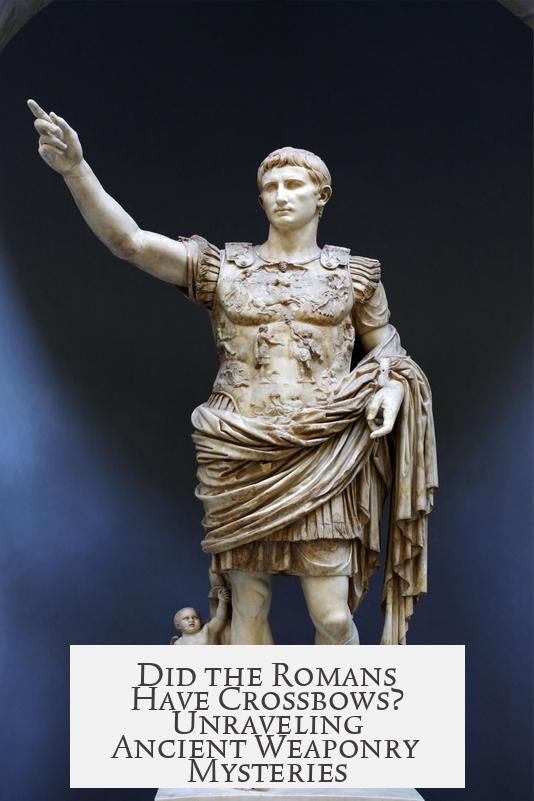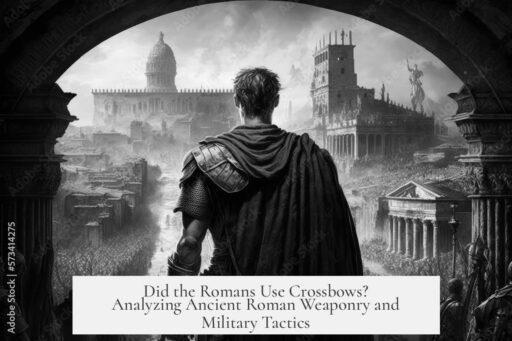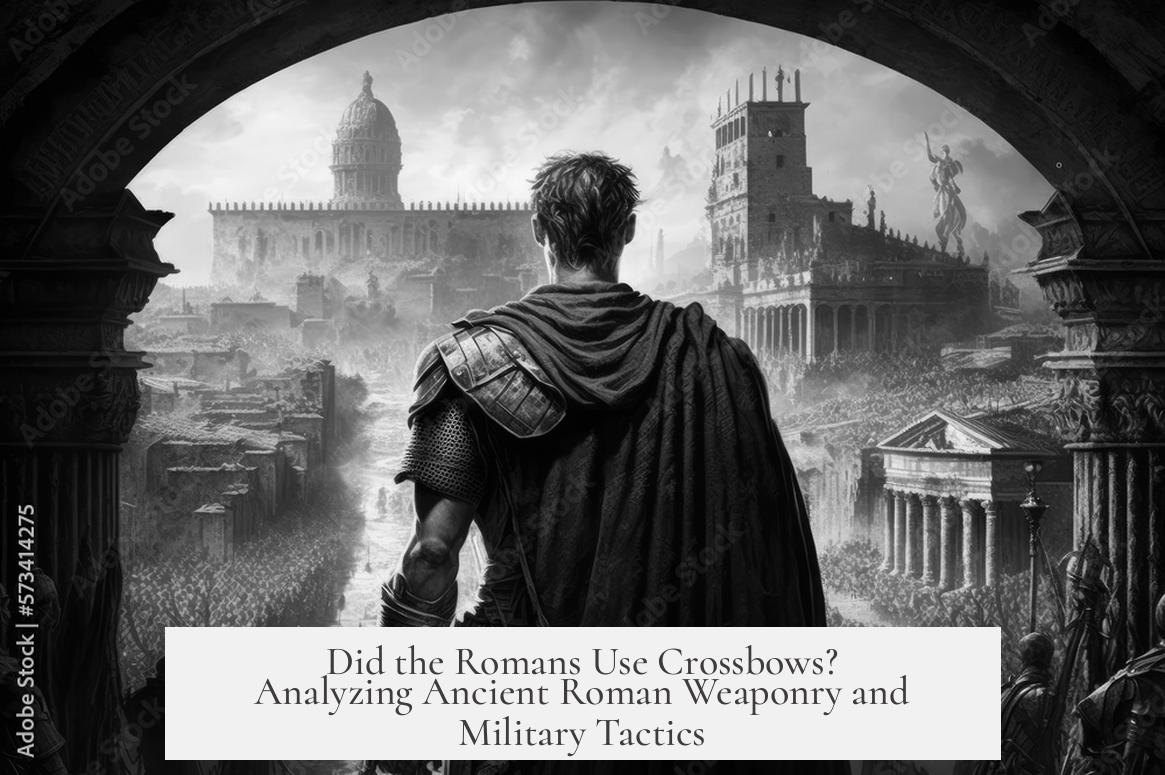The Romans did not have crossbows as we understand them today. They employed siege engines like the cheiroballistra (also called manuballista), which resembled heavy artillery rather than hand-held crossbows. Earlier Greek innovations influenced these devices, but true crossbows for personal use appear absent in Roman military arsenals.
The cheiroballistra was a Roman mechanical weapon, an evolution of the ballista and scorpio designs. It used torsion springs housed in metal cylinders spaced apart to increase power. This adaptation allowed it to fire bolts accurately over long distances as a light artillery piece. However, it was operated by two men and was not a portable, hand-held crossbow.
This distinction is critical. The cheiroballistra was an anti-personnel siege engine, delivering powerful shots from fixed positions. It was not a small device carried by soldiers like later medieval crossbows. Roman soldiers relied on archers with traditional bows rather than handheld mechanical bow weapons.
Long before Roman dominance, the Greek gastrophetes, developed in the 5th century BC, served as a semi-portable siege weapon. Although it was operated by a single person, it was still mainly used to launch heavy bolts in siege warfare rather than as a personal firearm. The gastrophetes was a precursor to the ballista but still did not resemble handheld crossbows in function or form.
Visual evidence of hand-held ballista-type weapons in the Roman period is limited and ambiguous. Some reliefs depict hunting contexts where individuals appear to use bow-like devices, possibly resembling crossbows. However, the Roman terms cheiroballistra and manuballista, meaning “hand-thrower,” refer more to the principle of the device than an actual handheld weapon.
Several stone relief carvings linked to Roman military graves in Gaul depict crossbow-like hunting weapons. Similarly, Pictish stones from later periods show figures carrying devices interpreted as crossbows. These images suggest some form of crossbow may have been known, but their military significance and exact usage remain unclear. The Pictish examples are religious or symbolic and do not provide evidence for widespread Roman military adoption.
Scholars debate both the existence and prevalence of crossbow-like weapons in Roman times. The limited archaeological and textual evidence struggles to support that such weapons were standard or common among Roman troops. Most experts conclude that the Roman army did not widely employ hand-held crossbows in combat.
The scholarly disagreement is notable and ongoing. Some researchers like Elton argue for greater recognition of these devices, but many others challenge those views, citing insufficient evidence. The lack of comprehensive primary sources and surviving artifacts leaves the debate open but leaning towards the absence of traditional crossbows in Roman arms.
| Weapon | Time Period | Type | Usage | Crossbow Status |
|---|---|---|---|---|
| Gastraphetes | 5th century BC (Greek) | Semi-portable siege weapon | Siege warfare | Not a crossbow |
| Cheiroballistra (Manuballista) | Roman period | Light artillery/battlefield engine | Anti-personnel bolts | Not a handheld crossbow |
| Hunting devices (Reliefs) | Roman and Pictish era | Ambiguous, possibly crossbow-like | Hunting/symbolic | Uncertain usage as weapons |
Evidence shows that Roman military power stemmed largely from disciplined infantry, legionary pilum (thrown javelins), and traditional string bows. Mechanical siege engines like the ballista family enhanced their capabilities but did not substitute for individual ranged weapons like crossbows. Crossbow-like devices were rare and possibly symbolic.
The discussion about Roman crossbows illustrates the complexity of military technology history. Terminology, surviving artifacts, and uneven historical records create challenges for researchers. Until further evidence emerges, the consensus holds that Romans lacked the crossbow as a hand-held weapon common in later medieval warfare.
- Romans used the cheiroballistra, a powered siege engine, not a hand-held crossbow.
- The gastrophetes was an earlier Greek semi-portable siege weapon, not a personal crossbow.
- Visual depictions of crossbow-like devices exist but relate mostly to hunting or symbolic contexts.
- Scholars debate the presence of Roman crossbows; evidence for widespread military use is weak.
- Roman infantry relied on bows, swords, and javelins over mechanical hand-held weapons.
Did the Romans Have Crossbows? Unraveling Ancient Weaponry Mysteries

Short answer: The Romans didn’t have crossbows as we imagine them today. While they wielded impressive missile engines, none quite match the handheld crossbows popularized later in Europe and Asia. But the story is far from simple; ancient weapons blur lines between ballista and bow, siege engine and personal armament.
Let’s unpack the curious case of Roman crossbows and their relatives. Why no clear crossbows? What about the cheiroballistra? Did Roman archers carry crossbow-like weapons? Grab your helmet and let’s march through time.
The Cheiroballistra (Manuballista): More Artillery Than Archery
The cheiroballistra — sometimes called the manuballista — is one of the most intriguing Roman missile devices. It’s linked to Hero of Alexandria, though historians debate whether he truly invented it or just refined existing tech.
This apparatus is an evolved ballista. Think of a giant, metal spring-powered catapult firing bolts with deadly accuracy. The springs, housed in spaced metal cylinders, amplify force. This innovation made it pressurize power without collapsing under strain.
Reconstructed models prove the cheiroballistra was effective artillery, firing bolts over long distances with precision. Two operators wield it, not lone soldiers. It’s a light siege weapon, not a pocket-size crossbow for frontline troops.
So, while it shares the idea of firing bolts like a crossbow, it’s not hand-held or soldier-carried. This massive engine sits somewhere between a ballista and a siege weapon.
Tracing Origins: The Gastraphetes, an Early Ancestor
Before Roman dominance, the Greeks built a weapon called the gastraphetes around the 5th century BC. This was a large handheld device fired from the stomach (hence the name, “belly bow”).
Was it a crossbow? Not exactly. It required two hands and body weight to operate. It delivered powerful bolts but functioned more like ancient artillery. Often seen as siege support, it paved the path for mechanical missile weapons like the ballista.
Romans eventually replaced the gastrophetes with ballista machines, focusing on bigger and more powerful designs rather than small handheld crossbows.
Handheld Crossbows in Roman Times? Visual Clues and Hunting Context
Here’s where things get foggy. Some ancient Roman reliefs show handheld, ballista-like weapons, but usually in hunting scenes, not battle arrays. Descriptions call them cheiroballistra or manuballista—both meaning “hand launcher”—but that doesn’t always mean “handheld weapon” the way we mean today.
Interestingly, several stone relief carvings from a Roman military grave in Gaul depict crossbow-like tools. These images hint at some handheld bolt shooters possibly used for hunting or specialized purposes.
Also, Pictish stones from northern Britain show figures holding objects resembling crossbows in symbolic or religious contexts. Sadly, the best example was lost in a fire; only sketches remain. This fragmentary evidence makes it tough to conclude widespread military use.
Why No Clear Crossbows in Roman Military? A Scholarly Debate

Historians argue persistently about crossbows’ presence in Roman warfare. Some suspect the Romans had handheld crossbow-type weapons in small numbers or specialized roles, but no good, concrete proof exists of wide use by regular infantry.
Many scholars lean toward “no” — conventional ballistae ruled Roman missile arsenals. Why not carry crossbows? The answer might lie in logistics: Maintaining and training on complex crossbows could have been harder than simpler bows and artillery.
Despite this, Oxford-published expert Elton argues differently, suggesting closer ties of these weapons to Roman forces. But even among enthusiasts and academics, consensus remains elusive.
“The scarcity of solid evidence convinces me that Roman crossbows weren’t widespread. Still, historical ambiguity invites curiosity.” — A modern historian’s musing.
What Does This Mean for Roman Warfare and Weaponry?
Romans excelled in engineering massed artillery weapons—ballistae, scorpios, catapults—supporting infantry with ranged firepower. Their approach favored heavy, stationary siege engines over mobile, handheld crossbows. Soldiers preferred traditional bows and javelins—simpler, battle-tested arms.
But would handheld crossbows have helped? Possibly. They need less strength and training than longbows, offering steady power. Hypothetically, they could bolster infantry defense or hunting. But Romans might have deemed mechanical complexity unnecessary when limits of ammunition supply and tactical doctrine prevailed.
Modern reconstructions of the cheiroballistra demonstrate marvelous engineering but reinforce the understanding: Roman “crossbows” were chiefly artillery pieces, not personal weapons.
Final Thoughts: An Invitation to Explore—and Question
The Romans didn’t possess handheld crossbows in the form familiar to later medieval Europe or East Asia. The cheiroballistra dazzles as an engineering feat but was used as light artillery. Earlier devices like the gastrophetes inspired these machines.
The visual evidence (Gaul reliefs, Pictish stones) hints at the curiosity for crossbow-style weapons but lacks proof of widespread military adoption. Scholarly debate mirrors the mystery—did such weapons exist in niche roles, or were they merely experimental?
For history buffs and weapon enthusiasts, it’s a splendid puzzle. You don’t need to give up the idea of Roman crossbows entirely; the ambiguity invites us to reconsider ancient innovation beyond simplified categories. Who knows what will surface from dusty archives next?
So, next time you picture a Roman legionary, don’t expect a handy crossbow. Instead, imagine a soldier backed by mighty artillery, disciplined formations, and engineering marvels that shaped ancient warfare.
If you want to dive deeper, join the fascinating discussion at AskHistorians thread on Pictish crossbows. The messy, lively debate showcases how history is as much about questions as answers.




